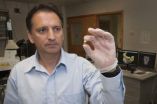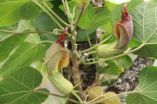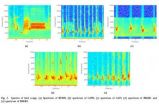(Press-News.org) GAINESVILLE, Fla. – Your teeth can tell stories about you, and not just that you always forget to floss.
A study led by University of Florida geology researcher George D. Kamenov showed that trace amounts of lead in modern and historical human teeth can give clues about where they came from. The paper will be published in the August issue of Science of The Total Environment.
The discovery could help police solve cold cases, Kamenov said. For instance, if an unidentified decomposed body is found, testing the lead in the teeth could immediately help focus the investigation on a certain geographic area. That way, law enforcement can avoid wasting resources checking for missing persons in the wrong places.
"We can use this pollution signal to figure out where these people came from," he said.
Lead is composed of four variants, called isotopes. The amount of those isotopes fluctuates in different rocks, soils and ores – and, therefore, regions of the world.
Mining and other pollution-causing activities release that lead into the environment, and it accumulates in children's bodies as they grow because kids inhale dust and ingest soil when they put their hands in their mouths.
Tooth enamel, which develops during childhood, locks in the lead signals and preserves them.
"When you grow up, you record the signal of the local environment," Kamenov said. "If you move somewhere else, your isotope will be distinct from the local population."
Even different teeth can reveal certain facts.
First molar enamel is finished forming by age 3, so it provides information about birth and toddler years. Incisor and canine enamel starts later and finishes around age 5, so it gives insight into early childhood. The third molar enamel does not start forming until age 8, so it indicates late childhood residences.
Lead analysis can also tell what time period a body is from.
Modern and historical teeth have different signals, according to the study. The natural composition of lead changed over the past century because of mining and the use of leaded gasoline, so there's a clear distinction between modern and historical human exposure.
Using that information, archaeologists can identify early European bodies in New World areas.
"You can go back in time, look at archaeological sites and try to reconstruct human migration," Kamenov said.
But modern American teeth are like no others in the world, according to the study. Whereas available data for areas such as South America overlap with Europe, American teeth can be identified anywhere due to usage of ores with distinct isotope signals in the United States.
"What's in the environment goes into your body," Kamenov said.
INFORMATION:
Brian L. Gulson from Australia's Macquarie University also worked on the study.
Lead in teeth can tell a body's tale, UF study finds
2014-07-31
ELSE PRESS RELEASES FROM THIS DATE:
Scientists discover biochemical mechanisms contributing to fibromuscular dysplasia
2014-07-31
An important step has been made to help better identify and treat those with fibromuscular dysplasia (FMD). FMD causes both an abnormal narrowing and enlarging of medium sized arteries in the body, which can restrict blood flow to the kidneys and other organs causing damage. In a new report appearing in August 2014 issue of The FASEB Journal, scientists provide evidence that that FMD may not be limited to the arteries as currently believed. In addition, they show a connection to abnormalities of bones and joints, as well as evidence that inflammation may be driving the ...
New paper describes how DNA avoids damage from UV light
2014-07-31
BOZEMAN, Mont. – In the same week that the U.S. surgeon general issued a 101-page report about the dangers of skin cancer, researchers at Montana State University published a paper breaking new ground on how DNA – the genetic code in every cell – responds when exposed to ultraviolet (UV) light.
The findings advance fundamental understanding of DNA damage by the UV rays found in sunlight. This damage can lead to skin cancer, aging and some degenerative eye diseases.
"Our paper advances foundational knowledge about how DNA responds to UV radiation. In our experiments, ...
Magnetic resonance imaging in patients with transient ischemic attack
2014-07-31
Transient ischemic attack (TIA) is a temporary event, which portends a higher risk of a disabling stroke following the TIA. However, the evaluation and management of TIA vary worldwide and is debated and controversial. Dr. Mohamed Al-Khaled from University of Lübeck in Germany considered With the development of brain imaging, particularly diffusion weighted imaging-magnetic resonance imaging (DWI-MRI), the diagnosis of TIA changed from time-based definition to a tissue-based one. DWI-MRI became a mandatory tool in the TIA workup. The DWI-MRI provides not only the evidence ...
Ligaments disruption: A new perspective in the prognosis of SCI
2014-07-31
Worldwide prevalence of Spinal Cord Injury (SCI) is ranging from 233 to 755 per million inhabitants, whereas reported incidence lies between 10.4 and 83 per million inhabitants per year. Thus, the socioeconomic impact of SCI associated with cervical trauma is high enough to be encountered within one of the most important worries in vast majority of developed countries.
The ability to predict recovery following SCI is of paramount importance to the physician's role in providing the best care and guidance to patients and families during the illness. Diagnosis of cervical ...
Brother of Hibiscus is found alive and well on Maui
2014-07-31
Most people are familiar with Hibiscus flowers- they are an iconic symbol of tropical resorts worldwide where they are commonly planted in the landscape. Some, like Hawaii's State Flower- Hibiscus brackenridgei- are endangered species.
Only a relatively few botanists and Hawaiian conservation workers, however, are aware of an equally beautiful and intriguing related group of plants known as Hibiscadelphus- literally "brother of Hibiscus".
Brother of Hibiscus species are in fact highly endangered. Until recently only one of the seven previously known species remained ...
Singing the same tune: Scientists develop novel ways of separating birdsong sources
2014-07-31
Researchers at the University of California, Los Angeles and the Chinese Academy of Sciences have pioneered a new study that could greatly improve current methods of localising birdsong data. Their findings, which ascertain the validity of using statistical algorithms to detect multiple-source signals in real time and in three-dimensional space, are of especial significance to modern warfare.
Recently published in the journal Unmanned Systems, the study demonstrates the validity of using approximate maximum likelihood (AML) algorithms to determine the direction of arrival ...
Gulf oil spill researcher: Bacteria ate some toxins, but worst remain
2014-07-31
TALLAHASSEE, Fla. — A Florida State University researcher found that bacteria in the Gulf of Mexico consumed many of the toxic components of the oil released during the Deepwater Horizon spill in the months after the spill, but not the most toxic contaminants.
In two new studies conducted in a deep sea plume, Assistant Professor Olivia Mason found a species of bacteria called Colwellia likely consumed gaseous hydrocarbons and perhaps benzene, toluene, ethylbenzene and xylene compounds that were released as part of the oil spill.
But, her research also showed that bacteria ...
Hope for the overweight
2014-07-31
White, brown and beige adipocytes, or fat cells, are inherently different. Each of these cell types has different functions and each plays its own role in metabolism. In the human body, white adipose tissue is by far the most prevalent. Its primary function is energy storage. On the other hand, brown adipocytes utilize available energy to generate heat but are only found in a few places in the adult human body. Beige adipocytes, which represent a special type of brown adipocytes, appear mixed with brown adipocytes in human brown adipose tissue or develop within the white ...
Privileged strategies for direct transformations of inert aliphatic carbon-hydrogen bonds
2014-07-31
Functional group transformations are central to organic synthesis. Traditionally, the functionalities used in such transformations are highly active organic groups such as halogens, ester groups and hydroxyl groups. Carbon–hydrogen bonds are ubiquitous structural motifs in organic compounds, but they are not considered to be functional groups because (1) in general, the bond dissociation energy of a C–H bond is high, and therefore, such bonds are thermodynamically hard to break; and (2) the selective activation of one C–H bond among many similar and different C–H bonds ...
Neutron tomography technique reveals phase fractions of crystalline materials in 3-dimensions
2014-07-31
The method overcomes limitations of existing techniques which are limited to the surface or small-sized specimens, and allows a 3-D representation of the phase fractions within the sample volume. The work has just been published in the journal "Advanced Materials".
"For many engineering applications it is of major importance to characterize the bulk of materials spatially, instead of only probing selected locations. The new method provides exactly that capability, and the HZB-UTK team has demonstrated it by using samples made from stainless steel that undergo a phase ...




